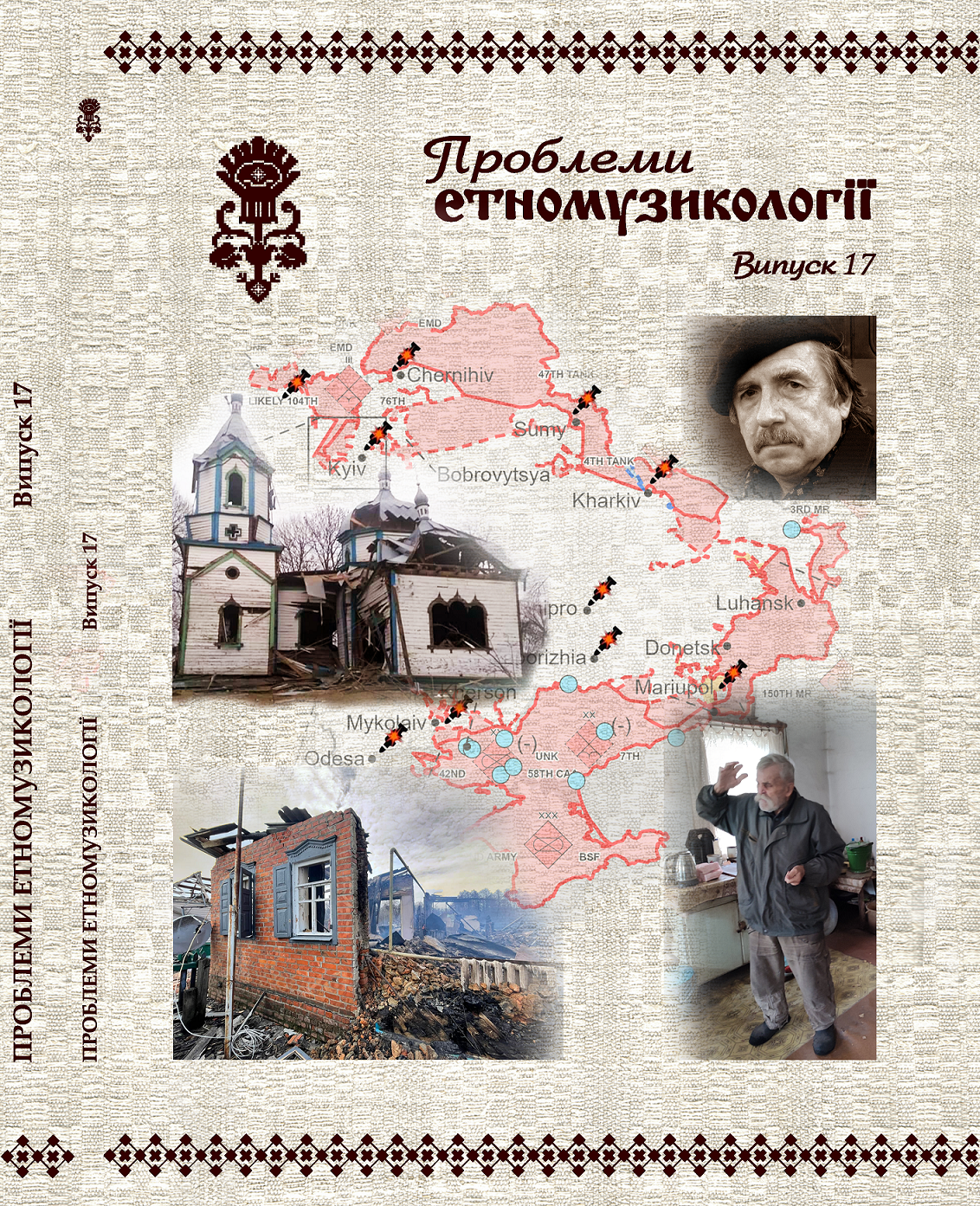Ромський музичний активізм в Україні під час російської окупації 2022
DOI:
https://doi.org/10.31318/2522-4212.2022.17.270905Ключові слова:
історія ромів, ромська музична культура , роми в Україні, російська окупація України 2022 року, сучасні форми музичного активізму ромівАнотація
У 1990-тих роках ромські чоловіки – професійні музиканти – використовували свій статус у ромських громадах, щоб стати голосом ромів у політиці. Історичний статус музикантів-чоловіків у своїх громадах допоміг їм отримати достатню підтримку як політичних лідерів у постсоціалістичних реструктуризаціях ромського суспільства. Після розпаду Радянського Союзу ромські музиканти були одними з перших, хто скористався можливостями розвитку, використовуючи свій соціальний статус у ромських громадах для заснування культурних організацій, які б гідно представляли ромів у навколишніх регіонах.
На сьогоднішній день цю роль перебрали ті їхні нащадки, котрі мали можливість здобути освіту (у тому числі й спеціальну музичну). Усе-таки, політизований характер музики в Україні – тенденція, що тягнеться з радянських часів – спонукає ромських активістів (зокрема, й музикантів) відстоювати права своєї етнічної групи в різних сферах культурного й політичного життя, в тому числі й музично-сценічними засобами.
Сучасні роми, незважаючи на історію насильства проти них, в умовах російсько-української війни, розпочатої 24 лютого 2022 року, борються за захист своєї батьківщини – України. Вони роблять це як безпосередньо у війську, так і у музично-сценічному просторі, додаючи до свого репертуару українські повстанські пісні та декоруючи виступ українським прапором.
Завантаження
Посилання
Beissinger, M. (1991). The Art of the Lăutar: The Epic Tradition of Romania. New York, NY: Garland Publishing.
Beissinger, M. (2001). Occupation and ethnicity: constructing identity among professional romani (gypsy) musicians in Romania. Slavic Review, 60 (1), 24–49. [in English].
Beissinger, M. (2016). Romanian Manele and regional parallels: «oriental» ethnopop in the Balkans. In book: M. Beissinger, S. Radulescu, and A. Giurchescu. (Eds.). Manele in Romania: Cultural Expression and Social Mean ing in Balkan Popular Music, pp. 95–138. Lanham, MD: Rowman & Littlefield Publishers. [in English].
Beissinger, M., Radulescu, S., and Giurchescu, A. (Eds.). (2016). Manele in Romania:Cultural Expression and Social Meaning in Balkan Popular Music. Lanham, MD: Rowman & Littlefield Publishers. [in English].
Beníšek, M. (2013). Serednye Romani: A North Central Romani variety of Transcarpathian Ukraine. In book: B. Schrammel-Leber and B. Tiefenbacher. (Eds.). Romani V. Papers from the Annual Meeting of the Gypsy Lore Society, pp.42–60. Graz, The University of Graz. [in English].
Beníšek, M. (2017). Eastern Uzh varieties of North Central Romani. [Ph.D. Dissertation]. Prague: Charles University. [in English].
Gelbart, P. (2010). Learning Music, Race, and Nation in the Czech Republic. [Ph.D. Dissertation]. Harvard University. [in English].
Hooker, L. (2013). Redefining Hungarian Music from Liszt to Bartok. Oxford, UK: Oxford University Press. [in English].
Kovalcsik, K. (2000). Teasing as a sung speech genre of Vlach Gypsy couples in the Sub-Carpathian region. Narodna umjetnost: Croatian Journal of Ethnology and Folklore Research, 37(1), 67–94. [in English].
Kovalcsik, K. (2010). The romani musicians on the stage of pluri-culturalism: the case of the Kalyi Jag group in Hungary. In book: M. Stewart and M. Rövid. (Eds). Multi-Disciplinary Approaches to Romany Studies, pp. 55–70. Budapest: Central European University Press. [in English].
Lange, B. Rose. (1997). Hungarian rom (gypsy) political activism and the development of folklór ensemble music. The World of Music, 39(3), 5–30. [in English].
Lange, B. Rose. (2003). Holy Brotherhood: Romani Music in a Hungarian Pentecostal Church. Oxford, UK: Oxford University Press. [in English].
Lange, B. Rose. (2018). Local Fusions: Folk Music Experiments in Central Europe at the Millennium. New York: Oxford University Press. [in English].
Laušević, M. (2006). Balkan Fascination: Creating an Alternative Music Culture in America. Oxford, UK: Oxford University Press. [in English].
Marković, A. (2017). Gypsy Fingers are Unique! Identity Politics and Musical Performance among Romani Musicians in Vranje, Serbia. [Ph.D. Dissertation], the University of Illinois at Chicago. [in English].
Pettan, Sv. (1996). Gypsies, music, and politics in the Balkans: a case study from Kosovo. The World of Music, 38(1), 33–61. [in English].
Pettan, Sv. (2001). Encounter with the «others from within»: the case of gypsy musicians in former Yugoslavia. The World of Music, 43(2/3), 119–137. [in English].
Pettan, Sv. (2002). Rom Musicians in Kosovo: Interaction and Creativity. Budapest, HU: Institute for Musicology of the Hungarian Academy for Sciences. [in English].
Pettan, Sv. (2015). Kosovo Through the Eyes of Local Romani (Gypsy) Musicians: study guide and dvd. Ljubljana, SL: University of Ljubljana, Faculty of Arts and the Society for Ethnomusicology. [in English].
Seeman, S. (2019). Sounding Roman: Representation and Performing Identity in Western Turkey. New York, NY: Oxford University Press. [in English].
Silverman, C. (2007). Trafficking in the exotic with «gypsy» music: balkan roma, cosmopolitanism, and «World Music» festivals. In book: D. Buchanan. (Ed.). Balkan Popular Culture and the Ottoman Ecumene: Music, Image, and Regional Political Discourse, pp. 335–364. Lanham, MD: Scarecrow Press. [in English].
Silverman, C. (2012). Romani Routes: Cultural Politics and Balkan Music in Diaspora. New York, NY: Oxford University Press. [in English].
Silverman, C. (2018). From reflexivity to collaboration: changing roles of a non-romani scholar, activist, and performer. Critical Romani Studies, 1(2), 76–97. [in English].
##submission.downloads##
Опубліковано
Номер
Розділ
Ліцензія
Починаючи з червня 2025 року авторське право на публікацію залишається за авторами.
Автори можуть використовувати власні матеріали в інших виданнях за умови посилання на журнал «Проблеми етномузикології» як на місце першої публікації.
Наш журнал дотримується авторських прав та дозволів CREATIVE COMMONS для журналів із відкритим доступом.
Автори, які публікуються в цьому журналі, погоджуються з такими умовами:
- автори лишають за собою право на авторство своєї роботи та передають журналу право першої публікації цієї роботи на умовах ліцензії Creative Commons Attribution-ShareAlike 4.0 International License, яка дає змогу іншим особам вільно поширювати опубліковане дослідження з обов'язковим посиланням на авторів оригінальної роботи та першу публікацію роботи в цьому журналі;
- автори мають право укладати самостійні додаткові угоди щодо неексклюзивного розповсюдження роботи такою, якою її було опубліковано цим журналом (наприклад, розміщувати роботу в електронному сховищі установи або публікувати у складі монографії), за умови збереження посилання на першу публікацію роботи в цьому журналі.




